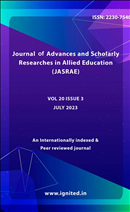A theoretical approach to analyse the importance of Government and non-governmental organisations' roles in lowering adolescent depressive symptoms in Orissa with hearing loss
Keywords:
Adolescent, Depression, Government assistance scopeAbstract
It is possible that hearing loss contributes to the development of some symptoms often associated with ageing, such as the inability to keep up with discussions, withdrawing from social engagements, and the formation of moderate paranoid tendencies. There may also be a connection between hearing loss and some depressive symptoms.There is a cluster of symptoms that all sufferers of depression share. Symptoms include persistent feelings of melancholy, worry, or emptiness, along with hopelessness or pessimism that last for weeks at a time.
A connection between the two is obvious; depressed people often have trouble hearing. It is common for people with hearing loss to have trouble communicating, which may lead to frustration, exhaustion, and isolation. Research has linked being lonely to feeling down and depressed.
References
M.Moeller- Current status of knowledge: psychosocial development in children with hearing impairment.
J.Fellinger. D Aolzinger, C.Bietel, M.Lancht, D.P Goldberg- The impact of language skills on mental health in teenagers with hearing impairments.
N.Konuk, A.Erdogan, L.Atik, M.B. Ugur, O-Simsekyilmaz-Evolution of behavioural and emotional problems in deaf children by using the child behavior checklist.
T.van Eldik- Mental health problems of Dutch youth with hearing loss as on the youth self report.
B. Birmaker, N.D Ryan, D.E. Williamson, D,A. Brent, J. Kaufman, R.E. Dhal, et al.- “childhood and adolescent depression: a review of the past 10 years.
Verron M, & Andrews J. (1990). The psychology of deafness. Newyork, NY: Longman.
Stickley A, Koyanagi A. Loneliness, common mental disorders and suicidal behavior: findings from a general population survey
Agrawal Y, Platz EA, Niparko JK. Prevalence of hearing loss and differences by demographic characteristics among US adults:data from the National Health and Nutrition Examination.
Boyce, W & Johnston, C. (1998). Collaboration in community based rehabilitation, International Journal of Rehabilitation.
Carroll, T.F. (1992). Intermediary NGOs. The supporting Link in Grassroots Development. West Hartford: Kumarian Press.
Lang, R. (2000). The Role of NGOs in the process of empowerment and social transformation of people with disabilities. Selected Readings in Community based Rehabilitation. Asia Pacific Disability Rehabilitation Journal, Bangalore.
WHO/UNESCO/ILO, (1994). CBR: Community Based Rehabilitation for Disabled People. Joint Position Paper, Geneva.











